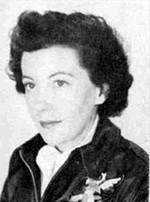
Four WASP members leaving their ship (US Air Force photo)
A long-time Anacortes resident who was a member of Women Airforce Service Pilots in World War II stands to receive the Congressional Gold Medal, if Congress approves legislation now under consideration.
 Lois Auchterlonie, who is 92, is one of about 300 former members of WASP who are still alive who would receive the nation’s highest and most distinguished civilian award.
Lois Auchterlonie, who is 92, is one of about 300 former members of WASP who are still alive who would receive the nation’s highest and most distinguished civilian award.
She graduated WASP training on Dec. 17, 1943, and was assigned to Williams Army Air Base in Ariz. Auchterlonie lived in Skyline for about 25 years. In January, following an illness, she moved to Everett to be near family.
Between 1942 and 1944, young women from across the country volunteered for flight training and service. They were America’s first women to fly military aircraft, and were recruited to fly non-combat missions. By the time the war ended, 1,102 female pilots received their pilot wings, and all told, they had flown over 60 million miles. They were disbanded before the end of WWII.
Following the war, each female pilot was ordered to leave the military. Women who lost their lives while serving their country were denied military honors, and surviving pilots were denied military benefits. It wasn’t until 1977 that the WASP women were provided the benefits they deserved.
Senator Maria Cantwell said “The women of the Women Airforce Service Pilots were not just part of the Greatest Generation, they were trailblazers who had a tremendous impact on the role of women in the military today.”
“By honoring these American heroines with the Congressional Gold Medal, we can finally commend and celebrate their courage, loyalty, and service to country that brought about a historic change in our armed services and our nation,” Cantwell said.
Thirty-eight WASP fliers lost their lives while serving their country during the war. Because they were not considered to be actually in the military under the existing guidelines, a fallen WASP was sent home at the expense of her family without any traditional military honors or note of their heroism.
Because of the pioneering and the expertise they demonstrated in successfully flying every type of military aircraft, from the fastest fighters to the heaviest bombers, the WASP blazed a trail for women of future generations to follow. The WASP had proven conclusively that female pilots, when given the same training as male pilots, were just as capable as men.

Of the 300 WASP still alive today. 12 live in Washington state.
Washington state Women Airforce Service Pilots:
- Lois (Dobbins) Auchterlonie, Everett
- Mary “Pat” (Hiller) Call, Mount Vernon
- Nancy A. (Nordhoff) Dunnam, Bellevue
- Elizabeth I. (White) Dybbro, Des Moines
- Margaret E. (Neyman) Martin, Oak Harbor
- Marjory V. (Foster) Munn, Seattle
- Elizabeth (Keatts) Munoz, Pomeroy
- Dorothy (Kocher) Olsen, University Place
- Andrea (Shaw) Shaw, Carnation
- Mary B. (Barnes) Sturdevant, Tacoma
- Josephine (Keating) Swift, Seattle
- Alta C. (Corbett) Thomas, Sequim